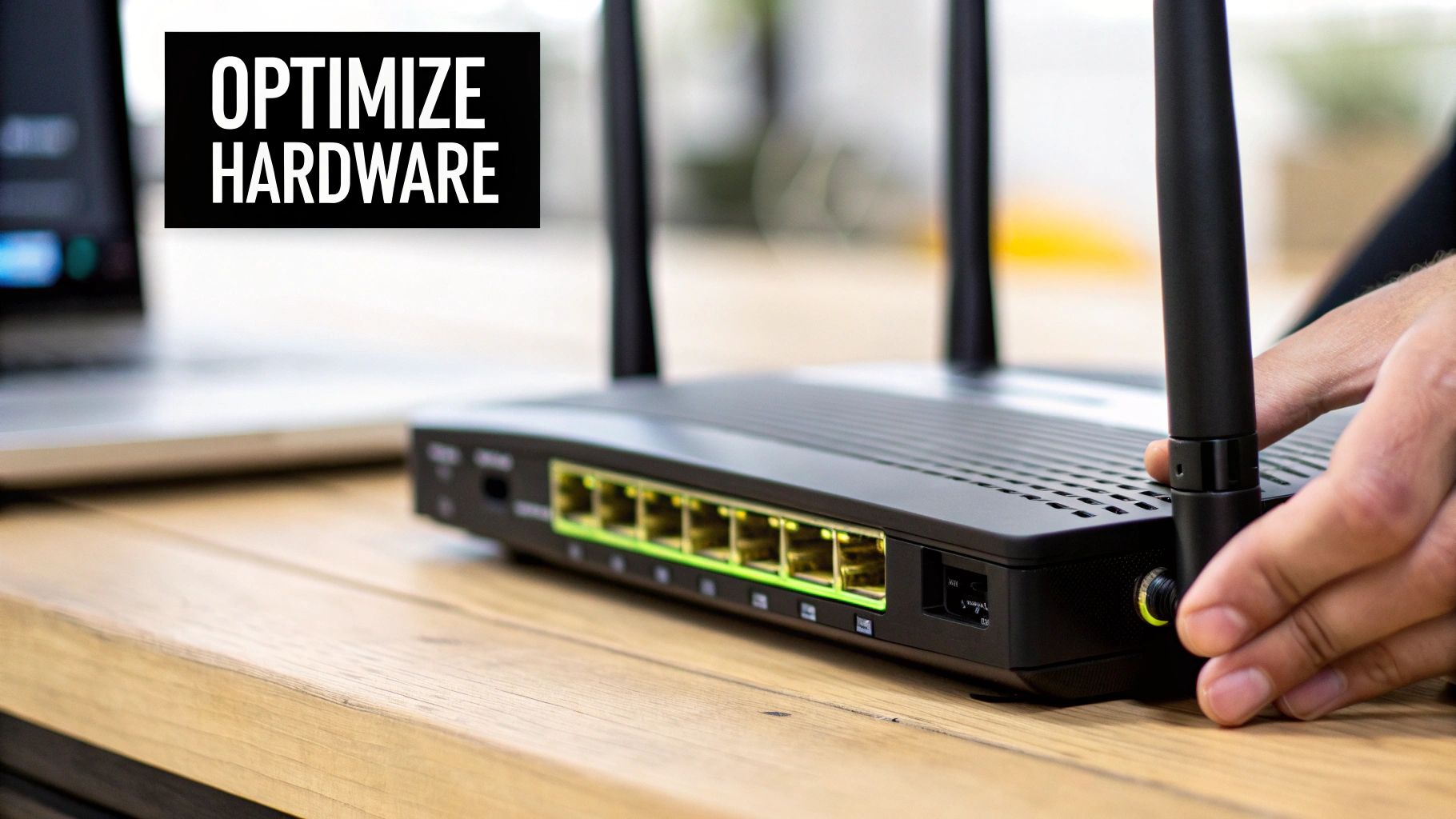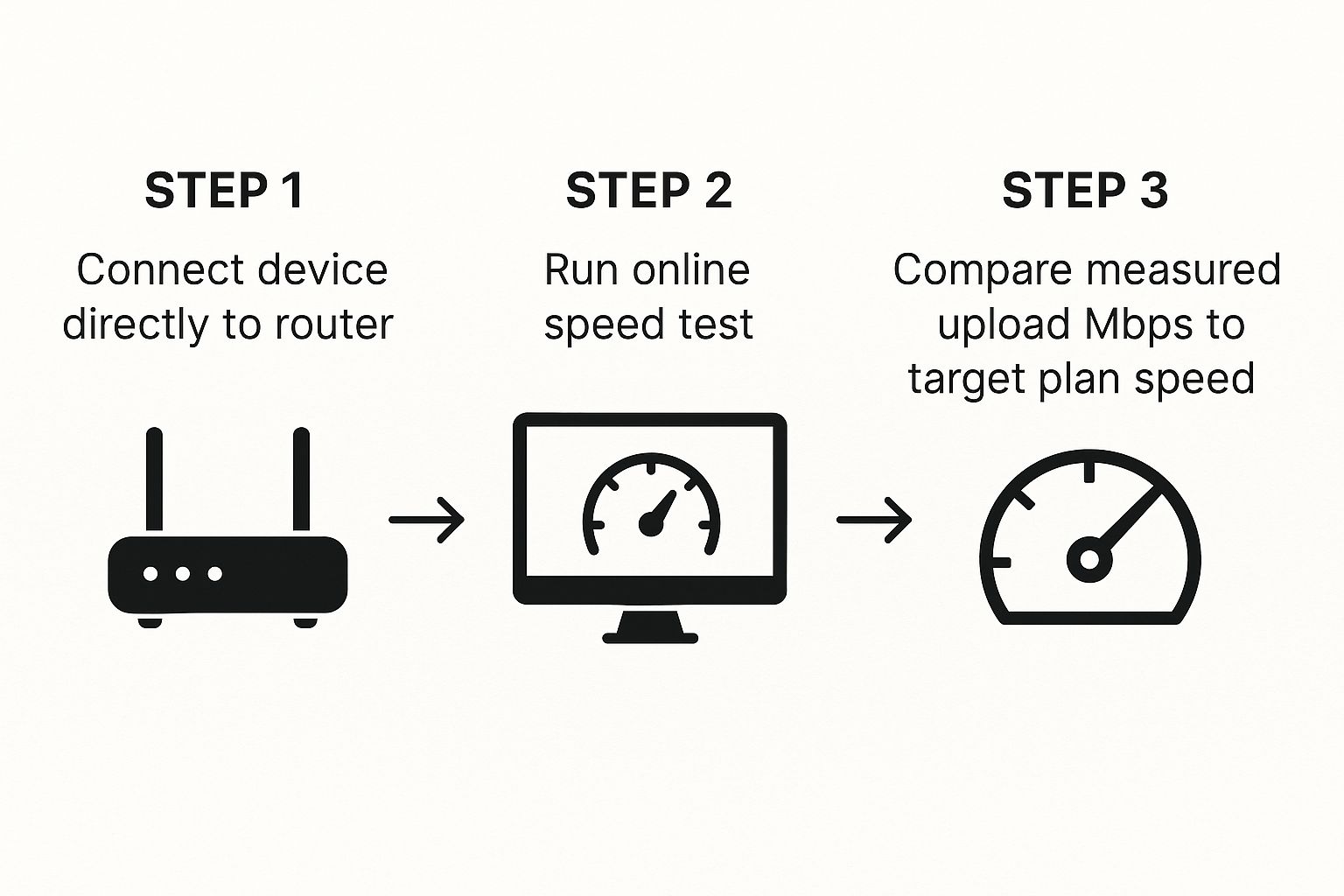Your Guide to Achieving Faster Upload Speeds
Let’s be honest, we’ve all been there: staring at a progress bar that’s barely moving, waiting for a critical file to upload. It’s a frustrating and all-too-common bottleneck. Getting faster upload speeds really comes down to a two-part game plan: fine-tuning your network connection and, just as importantly, shrinking your files before you even start the upload.
This guide will walk you through practical steps for both, so you can stop waiting and get back to work.
Why Upload Speed Is No Longer an Afterthought

For years, internet service providers have sold us on one thing: download speed. That big, flashy number was all anyone seemed to care about. But if you’re a content creator, work remotely, or collaborate with a team online, you know the painful truth—your upload speed is often the real performance killer.
A sluggish upload connection isn't just a minor inconvenience. It has real, tangible consequences that throw a wrench in your workflow and kill productivity.
- Pixelated Video Calls: Ever had your video feed turn into a blurry, pixelated mess during an important client meeting? That’s often a direct result of not having enough upload bandwidth.
- Wasted Hours: Trying to send a large project file, like a final video edit or a gallery of high-resolution photos, can feel like an overnight task instead of a quick, simple transfer.
- Cloud Sync Nightmares: Inefficient upload speeds mean your cloud storage is always playing catch-up, leaving your backups and shared documents hopelessly out of sync.
Before diving into solutions, it's helpful to understand the main things that control how fast you can upload files. These are the core factors at play every time you hit "send."
Core Factors Impacting Your Upload Speeds
| Factor | How It Affects Your Speed | Quick Tip |
|---|---|---|
| ISP Plan | This is the hard cap on your speed. You can't upload faster than what your plan allows. | Check your plan’s advertised upload speed—it's often much lower than the download speed. |
| Network Congestion | If many devices are using your network, your available upload bandwidth gets split among them. | Pause other large uploads or downloads on your network when you need max speed for one task. |
| File Size | The bigger the file, the longer it takes to upload. It’s a simple but crucial relationship. | Compress large files before uploading. Even a 20% reduction can save significant time. |
| Wi-Fi vs. Ethernet | A wired Ethernet connection is almost always faster and more stable than Wi-Fi. | For important, large uploads, plug your computer directly into the router with an Ethernet cable. |
Understanding these basics gives you a clearer picture of where the bottlenecks are. Now, let’s get into the practical side of things.
The Modern Importance of Uploads
The way we all use the internet has fundamentally changed. We're not just consuming content anymore; we're actively creating and contributing. This shift makes solid upload capability non-negotiable. Activities like live streaming and real-time cloud collaboration simply wouldn't be possible without it.
Interestingly, as of March 2025, the median upload speed for fixed broadband worldwide is still significantly higher than for mobile connections. This really highlights why a stable home or office connection is critical for any data-heavy work. For more insights, you can dig into the latest global internet speed research from Statista.
The core idea is simple: You can't have an efficient modern workflow without efficient upload speeds. It’s the invisible engine powering digital collaboration.
This guide is all about action. We’re going to give you a powerful, two-pronged solution you can use today. First, we’ll dive into how to strategically optimize your network. Then, we’ll show you how to use a tool like Compresto to intelligently shrink your files before they ever leave your computer, guaranteeing a faster, smoother experience every time.
Finding the Source of Your Slow Uploads
Before you can get faster uploads, you need to play detective. Guessing at the problem won't get you anywhere—you need to pinpoint what’s actually causing the slowdown. A clear diagnosis is the only way to find a real solution.
The first move is always to run a proper speed test. This gives you hard numbers to work with, showing your current download and upload speeds. We’re focused on the upload number here, and you’ll almost always find it’s way lower than your download speed.
Once you have your results, check them against the speeds your internet provider promised you. If there’s a huge gap between what you’re paying for and what you’re actually getting, that’s a red flag that something is off on your end.
Diagnosing Common Bottlenecks
Most of the time, slow uploads come down to just a few usual suspects. By checking them one by one, you can usually figure out what’s holding you back.
- Weak Wi-Fi Signal: Are you trying to upload a huge file from the other side of the house? Walls, floors, and even big appliances can absolutely wreck your Wi-Fi signal, bringing your upload speeds to a crawl.
- Outdated Router: If your router is a few years old, it might not support the latest Wi-Fi standards or have the muscle to handle today's internet traffic. It can easily become the weak link in your setup, no matter how fast your internet plan is.
- Network Congestion: Your internet connection is like a highway. During "internet rush hour"—usually in the evenings when everyone in your house and neighborhood is streaming, gaming, and browsing—the whole network gets clogged up, and everything slows down.
Knowing the specific issue turns a frustrating problem into an actionable plan. It's the difference between blindly buying a new router and simply moving closer to the one you already have.
It's also worth remembering that global internet infrastructure sets the ultimate speed limit. For example, in March 2025, Singapore boasted an average fixed broadband speed of 345.33 Mbps, while the United States came in 13th at 203.81 Mbps. These numbers, which you can explore further with these global broadband speed comparisons on Statista, show just how much location can matter. By finding and fixing your local bottlenecks, you can make sure you're getting every bit of speed your connection can offer.
Immediate Network Fixes for Better Uploads

You don’t need to be a network engineer to get faster upload speeds. In my experience, some of the biggest wins come from small, practical adjustments to your setup and daily habits. These low-effort tweaks can deliver surprisingly good results right away.
When you’re facing a tight deadline, like sending a final project to a client, Wi-Fi can be your worst enemy. The single best thing you can do for a rock-solid connection is plug an Ethernet cable directly into your router. It cuts through signal interference and gives your data a clear, consistent pipeline to the internet.
Beyond your hardware, think about timing. If you're pushing a massive file, try to schedule it for off-peak hours—late at night or early in the morning. This lets you sidestep the "internet rush hour" when everyone in your neighborhood is online, which can seriously drag down your speeds.
Simple Router Maintenance for Better Performance
Your router is the unsung hero of your home network, and a little maintenance goes a long way. These small actions can have a noticeable impact on your connection’s reliability and speed.
- Reboot It Regularly: Just like a computer, your router gets bogged down over time. A simple power cycle once a week can clear out memory glitches and get things running smoothly again.
- Check for Firmware Updates: Router manufacturers release updates to patch security holes and improve performance. A quick visit to your router’s admin page can tell you if a newer version is available.
- Find the Right Spot: Don't hide your router in a cabinet or behind the TV. For the strongest signal, place it in a central, open location away from walls and large metal objects.
The goal is to create the clearest possible path for your data. A direct cable connection is always best, but optimizing your Wi-Fi signal is the next best thing for everyday use.
Looking at the bigger picture, the expansion of 5G has been a huge boost for mobile internet, pushing both download and upload speeds higher. Between 2023 and 2025, global median cellular download speeds jumped by over 80%. This shows just how much infrastructure improvements matter for getting faster uploads.
For a deeper dive into improving your connection, check out these easy tips to increase your upload speed.
While network fixes are crucial, remember they work best when you’re also sending smaller files. For the other half of the speed equation, take a look at our guide on file size reduction tips.
Here's the rewritten section, crafted to sound like an experienced human expert, following all the specified requirements.
The Smart Way to Upload Less and Finish Faster
What if the secret to faster uploads has less to do with your internet plan and more to do with the files themselves? The logic is simple, but it’s something I’ve seen transform workflows time and time again: smaller files upload exponentially faster. This is where smart file compression, especially with a dedicated tool like Compresto, becomes a total game-changer.
Instead of staring at a progress bar for hours, you can dramatically shrink a file before it ever leaves your computer. This one simple step can turn a frustrating, marathon upload into a task that’s over in just a few minutes. The trick is to cut down the data you’re sending without sacrificing the quality that actually matters for your work.
Using Compression to Your Advantage
Let’s talk about a real-world scenario I see all the time. Imagine you’re a freelance videographer rushing to hit a client deadline. You’ve got a 10GB project file that needs to get uploaded for review. On an average home connection, that could easily take over an hour—and that’s if your internet is perfectly stable. One little network hiccup, and you could be starting all over again.
This is the perfect moment for compression. Using a tool like Compresto, you can process that video file and knock its size down by 50-70% or even more, with little to no noticeable drop in visual quality. Suddenly, that 10GB beast becomes a much friendlier 3GB file. The difference in upload time isn't just small; it's massive.
As you can see, the dashboard is clean and straightforward. You can just drag your files in, pick your settings, and you're good to go.
What’s really powerful is the ability to balance file size against quality with a simple slider. This control is crucial. For a final delivery, you might lean toward higher quality. But for a quick internal preview? Crank up the compression and get it sent in record time. This kind of strategic thinking puts you back in charge of your own efficiency.
The fastest way to boost your upload speed often isn't buying a faster internet plan—it's sending less data. Compression lets you do exactly that, intelligently and on your own terms.
Choosing the Right Compression Level
Here’s where a bit of strategy comes in. You don’t need to use the same settings for every single file. The best approach depends entirely on what the file is and who it’s for.
- Internal Reviews: Sending a video draft to a colleague for feedback? Go with a higher compression setting. The main goal here is speed, not pixel-perfect quality.
- Client Previews: A balanced approach is your best bet. You need a file that uploads fast but still looks professional and represents your work well. A medium compression setting usually hits the sweet spot.
- Final Delivery: When it’s time to send the finished product, you’ll want to use lower compression to keep as much quality as possible. Even a small reduction in file size at this stage can save you valuable upload time without any creative compromises.
By tailoring your compression to the situation, you stop being at the mercy of your internet connection. You start actively managing your upload times and building a much more efficient, responsive workflow.
Combining Network Tweaks and Compression for Maximum Speed
This is where the magic really happens. By layering smart network optimizations on top of powerful file compression, you can achieve upload speeds that neither method could ever manage on its own. It's the synergy between these two tactics that unlocks truly dramatic improvements.
Think about it in a real-world scenario. A marketing team needs to get a 1GB promotional video to a client. Over a spotty Wi-Fi connection, this could easily chew up 40 minutes or more. But by combining our strategies, the whole picture changes.
First, a simple network fix: switching to a stable, wired Ethernet connection. That alone provides a much more reliable pipeline for the data. Then, add Compresto into the mix to shrink that 1GB file down to a mere 250MB—a 75% reduction. Suddenly, you're sending a much smaller file over a much better connection.
The result? That 40-minute upload nightmare is over in less than six minutes. This isn't just a small bump in speed; it's a fundamental shift in your workflow efficiency.
Your Integrated Workflow Checklist
To make this a regular part of your process, you need a simple, repeatable checklist. This infographic gives you a quick way to test your raw connection speed before you even start compressing.

Running a quick test like this establishes a baseline. It confirms you’re getting the speed you pay for from your internet provider. From there, just build these habits into your daily routine:
- Prioritize a Wired Connection: Whenever you’re dealing with large or critical uploads, ditch the Wi-Fi and plug in an Ethernet cable. It’s the single best thing you can do for connection stability.
- Compress Before You Send: Make it second nature to run big files through a compression tool first. To get the best results, it's worth exploring advanced video compression techniques that can seriously cut down file sizes.
- Choose the Right Tool: Not all compression software is created equal. Some are faster, more efficient, and produce better quality results. To see how we stack up, check out our article on the 10 reasons Compresto outperforms other compression tools.
Frequently Asked Questions About Upload Speeds

Even with the best tools and a solid game plan, you might still have a few lingering questions about getting your files uploaded faster. We get it. Let’s tackle some of the most common ones we hear to help you fine-tune your workflow and clear up any confusion.
This is where we get into the nitty-gritty, covering everything from hardware upgrades to software concerns so you have all the pieces of the puzzle.
Will a New Router Really Give Me Faster Upload Speeds?
It can definitely help, but it’s not a magic bullet. If your router is a few years old or doesn't support modern standards like Wi-Fi 6, a new one can provide a much stronger, more stable signal. That stability is what really matters for consistent upload performance, especially with large files.
Just remember, a new router cannot increase the maximum speed you pay for from your Internet Service Provider (ISP). Think of it like this: you can install brand-new, high-capacity pipes in your house, but it won’t change the water pressure coming from the city's main line. It just makes sure you're getting the most out of what you have.
Does File Compression with Tools Like Compresto Reduce Quality?
This is a great question, and the answer depends entirely on the settings you choose. For things like documents, spreadsheets, or code, you can use lossless compression. This method shrinks the file size with zero quality loss. It’s like vacuum-sealing your clothes—everything is still there, just packed more efficiently.
For media like photos and videos, you’ll typically use lossy compression, which involves a trade-off between file size and quality. But tools like Compresto put you in control. You can often achieve a massive reduction in file size with a quality drop so minimal that it’s practically imperceptible to the human eye.
The real power of modern compression is achieving faster uploads without making a noticeable creative sacrifice. It’s about being smart with your data.
Is It Better to Use a Wired or Wireless Connection for Uploading?
For any large or important file transfer, a wired Ethernet connection is almost always the superior choice. Hands down. It gives you a direct, stable link to your modem that isn't susceptible to interference from other devices, walls, or even just someone walking past.
Wi-Fi is incredibly convenient, of course, but its performance can fluctuate. If you need to maintain consistent and faster upload speeds for a critical task, nothing beats the reliability of plugging in a physical cable.
If I Compress a File Can the Other Person Open It?
Yes, in nearly all cases. It’s a common worry, but modern compression is built for compatibility.
When you compress files into a standard format like a .zip archive, the recipient can open it on any modern computer, usually just by double-clicking. No special software is needed; it's a universally supported format.
If you’re compressing a media file, like a video, as long as the file extension (e.g., .mp4) stays the same, anyone with a standard media player can open and view it. For a more detailed breakdown of common questions, feel free to check out the Compresto full FAQs page.